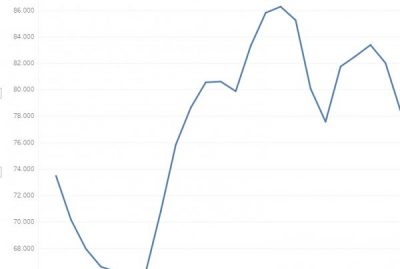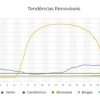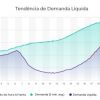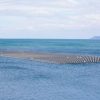The demand for converting the global energy matrix to a clean and renewable matrix stops being a desire and becomes a necessity given the environmental, economic and social impacts of traditional energy sources.
Changing the energy matrix does not depend solely on political good will and economic conditions. There are technical difficulties with the entry of a significant number of large plants using intermittent sources such as solar and wind, which require the adoption of storage systems to stabilize the electrical system in different time windows.
Grid stability and excess solar power
An energy distribution network generally does not have any energy accumulation element. The ONS (National System Operator) must at all times analyze the amount of energy generated and the amount of energy consumed in order to balance the two numbers.
Excess or lack of energy generation can cause voltage and frequency imbalances in the network, causing instability and cascading failures that can, in extreme cases, cause a large-scale shutdown.
The high penetration of intermittent sources in a non-storage power grid makes stability control very difficult.
Energy storage is a key part of enabling the expansion of the use of energy sources such as solar and wind, mitigating problems with grid stability.
In addition to the problem of introducing new energy sources, electrical systems traditionally suffer from consumption profiles, which change throughout the days and months of the year.
Figure 1 shows a typical load curve of the Brazilian electrical system on a summer day. There are peaks in consumption at certain times, mainly caused by the use of air conditioning units.
In addition to daily peaks, which require constant control of the dispatch of hydroelectric and thermoelectric plants, these profiles change over time and require the adoption of different dispatch strategies throughout the year.
The massive adoption of storage systems in electrical systems, in addition to facilitating the penetration of new intermittent sources, can make network control smoother, saving water in hydroelectric reservoirs and avoiding the entry of thermoelectric plants to meet peak demands.

The Californian operator CAISO (California Independent Service Operator) is an example of a distributor with strong penetration of solar energy. Taking July 22, 2020 (North American summer) as an example, we can see (Figures 2 and 3) that at the time of maximum solar energy generation, this source represented 12 GW of power, compared to around 25 GW of total power, thus showing a share of almost 50% of the generation power available on the network.


In the previous figures, while solar generation is at its peak, other sources are controlled to have their power reduced and guarantee the stability of the distribution system.
However, in the late afternoon solar energy decreases drastically, while the demand for energy increases, as exemplified in Figure 1 for the Brazilian electrical system.
This difference between available power and required power makes it necessary to have a sudden increase in power from other generation sources (in the CAISO network, mainly natural gas, traditional hydroelectric plants and the purchase of energy from neighboring states) and creates difficulties for the system operator.
A place with a lot of solar generation will at some point need storage technologies or thermoelectric or hydraulic plants to complement its generation.
Figure 4 illustrates curves that show the hourly behavior of energy demand from the CAISO operator's electrical network throughout the day. The sharp drop in consumption at the beginning of the day and the sharp increase in the late afternoon cause the need to activate auxiliary plants from dispatchable and non-renewable sources.
Figure 5, in turn, displays different consumption curves of an electrical network for the same day in different years, showing how the consumption profile has been changing over the years, making the management of electricity networks more complex, a fact which can be aggravated by the penetration of intermittent power sources.
It is worth remembering that this situation does not occur for low levels of penetration, as in the Brazilian case, where only a small fraction of energy comes from solar and wind sources – a situation that should change in the coming years.

![Figura 5 - Variações da demanda horária de consumo de uma rede elétrica ao longo dos anos, com a acentuação da variação de demanda ao longo das horas do dia. Fonte- [2]](https://canalsolar.com.br/wp-content/uploads/2021/03/Variacoes-da-demanda-horaria-de-consumo-de-uma-rede-eletrica-ao-longo-dos-anos-com-a-acentuacao-da-variacao-de-demanda-a-100x100.jpg)
Large-scale storage with reversible hydraulic plants
A proposed solution for the scenario of high penetration of intermittent sources, such as solar and wind, is large-scale energy storage. We can use storage to smooth out the sharp variations in the power curves of solar and wind power plants, or to absorb generation peaks during periods of higher generation.
A smoother generation curve allows for greater grid security, as power flow variations are slower, and also resolves a common criticism for intermittent sources, which require the assistance of thermoelectric plants at times of high consumption and low generation. .
The presence of storage systems increases generation predictability, reducing dependence on complementary polluting sources in systems with strong penetration of solar and wind sources.
Another aspect in which large-scale storage systems can be beneficial is in association with climate prediction models and generation planning for intermittent sources.
There are already studies that correlate climate models [3] to predict solar or wind energy generation, associated with storage and control systems, in order to reduce the intermittency of these sources.
Energy storage is closely associated with the idea of electric batteries, which are primarily great for short-term storage and generally have daily charge and discharge cycles.
This type of storage system plays an important role in many scenarios in electrical networks – and is even the most appropriate for applications with small generators (such as distributed generation, for example).
To allow a large penetration of sources such as solar energy into electrical systems, it is essential that in addition to short-term storage with batteries (cycles of hours or days), we have large-scale storage available (medium and long term), with storage capacity of weeks, months and even years.
Among the means of medium and long-term energy storage, the one that stands out the most and is the subject of many studies [4] is pumping water into hydroelectric plant reservoirs using solar and wind energy.
This type of system uses reversible hydroelectric plants associated with solar or wind energy sources, and can operate with the solar source in two different ways: hybrid (with solar energy dispatched to the grid) or exclusive (solar only for pumping).
A hybrid hydroelectric plant is one in which solar energy is used to complement the hydroelectric plant's generation and, if necessary (scenario of high penetration and surplus solar energy), use its energy to pump water to the reservoir.
Solar energy exclusively for pumping does not have a direct connection to the distribution network, being used only to pump water, with the advantage of being cheaper and simpler to implement.
Pumping water into hydroelectric plant reservoirs is a process with an efficiency of around 80% [5]. Although less efficient than electrochemical batteries, pumped water storage is available on a large scale and can allow massive penetration of solar and wind sources into electrical systems.
Instead of sending energy intermittently to the grid, energy is stored in hydraulic batteries for later use, according to demand.
The reservoirs of reversible plants (which have pumping systems) are true hydraulic energy batteries, which can be charged or discharged like traditional electrochemical batteries.
In times of surplus solar energy, water is pumped to the high reservoir. At times of greater energy demand, the hydroelectric plant increases its flow to the generation turbines.
This type of storage is even capable of storing energy for long periods of time. For example, surplus solar energy in summer can be transformed into stored potential energy (increasing the level of water reservoirs) and converted into electrical energy through the flow of water through the hydroelectric plant in winter.
Using climate prediction models, we can store energy for rainy or cloudy weeks in which solar energy generation is greatly hampered.
Photovoltaic modules can even be installed on floating structures in reservoirs, reducing water evaporation, improving their performance due to the reduction in temperature and taking advantage of a previously idle area.

This type of storage does not come without its challenges: building new hydroelectric plants involves large investments and environmental impacts. The answer to this problem is the retrofitting of existing plants.
The implementation of floating photovoltaic plants and the installation of water pumps form a perfect combination, which does not require major renovations of existing plants.
There are already plants in the world where the turbine itself that rotates with the fall of water already has an integrated pumping mechanism that returns water to the upper reservoir when there is surplus generation, as illustrated in Figure 9.
In the system illustrated, water is pumped to the upper reservoir when there is excess energy in the system and is drained at times of peak consumption, increasing the dispatch of electrical energy to the grid according to demand.
A very interesting project of a reversible hydraulic plant combined with solar generation is being carried out in Australia by the company Genex Power. The plant will use the crater of a deactivated mine as a reservoir.
A nearby solar plant will provide energy for pumping, allowing solar energy to be stored for later dispatch at peak consumption. The solar plant has a power of 270 MW and the reservoir has the capacity to store 200 MWh.



Pumped storage plants in Brazil and around the world
Reversible hydroelectric plants are already a reality in many countries, including Brazil. In 2019, according to the IEA (International Energy Agency), the world already had 127 GW of pumped storage hydroelectric plants, which represented 99% of all global storage power.
The same body predicts that by 2050 we should reach 309 GW of power in reversible hydroelectric plants associated with renewable sources. Today the world has 1267 GW of traditional hydroelectric plants, without reversibility.
Brazil is a world reference in hydroelectric plants, with a high share of this source in its energy matrix, around 60%. Even with expertise in the area, the country has very few reversible hydroelectric plants.
A survey carried out recently [7] shows that, both in quantity and power, the country is lagging behind in the use of this type of storage, with only 4 plants in operation.
Table 1: Reversible hydroelectric plants in Brazil
Much of Brazil's water resources have already been explored. Due to the environmental obstacles caused by the flooding of large areas and the economic difficulty of making investments in the construction of new plants, it is expected that there will be a decrease in the number of new projects of this type.
Although the country still has a lot of potential for growth in solar and wind energy before technical difficulties such as CAISO arise, it is inevitable that the bodies responsible for energy planning will encourage the construction of reversible hydroelectric plants or promote the adaptation of existing plants. to this end.
Currently, the great discussion about the viability of these projects revolves around three factors [8]:
- The remuneration model for this type of application only remunerates the energy generated and not the benefits of power availability, storage and network stability that the technology allows;
- High pumping cost;
- Environmental licensing for hilltops.
The cost of the solution, just analyzing the photovoltaic solar energy aspect, should decrease in line with the solar market, along with the development of new pumping solutions and the reuse of flooded areas with floating solar panels.
Regarding the environmental aspect, flexibility is proposed for the construction of artificial reservoirs on hilltops.
A future with a large share of pumped storage plants is not far from happening. The Ten-Year Energy Expansion Plan [9] already provides for the construction of pumped storage plants in Brazil from 2026 onwards.
Reversible plants, combined with other types of energy accumulation systems, are essential to guarantee a scenario with high penetration of renewable energy sources in the energy matrix.
References
[1] Analysis of the benefits of adhering to the white tariff as a form of residential energy management. Evandro André Konopatzki, Samir Ferreira, Filipe Marangoni, 2015
[2] What the duck curve tells us about managing a green grid, CAISO, California, USA
[3] Optimal operation scheduling of pumped storage hydro power plant in power system with a large penetration of photovoltaic generation using genetic algorithm. Aihara R, Yokoyama A, Nomiyana F, Kosugi N. In: Power Tech, 2011 IEEE Trondhaim 2010
[4] A review of mechanical energy storage systems combined with wind and solar applications. Mahmoud, M., Ramadan, M., Olabi, A.-G., Pullen, K., & Naher, S. Energy Conversion and Management, 2020
[5] Pumped hydro energy storage system: A technological review. Renewable and Sustainable Energy Reviews. Rehman, S., Al-Hadhrami, L.M., & Alam, M.M., 2015
[6] Solar-wind-pumped hydro energy storage systems: review and future perspective. Javed, M.S., Ma, T., Jurasz, J., & Amin, MY Renewable Energy, 2020
[7] Reversible hydroelectric plants in Brazil and around the world: application and perspectives. Canales et al. Electronic Magazine on Management, Education and Environmental Technology Santa Maria. v. 19, no. 2, May-Aug. 2015
[8] Reversible Hydroelectric Power Plants: A brief conceptual review and perspectives for the Brazilian scenario. Thiago Modesto de Abreu, Bernalize Vila Nova, Edson Bortoni, José Lima, 2020
[9] Ten-year expansion and energy plan 2030, EPE
[10] Today's Outlook, CAISO, California, USA

















2 Responses
Congratulations on the article
Excellent article, makes us see the viability of large-scale energy storage efficiently! I am a specialized professional from hydroelectric plants and I believe that the future of “intermittent” renewable energies depends greatly on our ability to store this energy in an intelligent and efficient way.